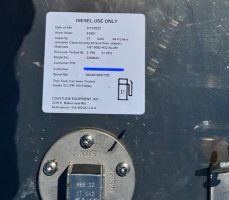You are using an out of date browser. It may not display this or other websites correctly.
You should upgrade or use an alternative browser.
You should upgrade or use an alternative browser.
Plastic Diesel Fuel tanks--Worrisome Outcome for "Tally Ho"
- Thread starter Christian Williams
- Start date
Prairie Schooner
Jeff & Donna, E35-3 purchased 7/21
Does it seem to you as though there are more instances of work done by professionals that is sub-par?
Also, it was sad to see that beautiful solid wood unit painted. I know it had to be done, but it was so pretty in raw wood.
Also, it was sad to see that beautiful solid wood unit painted. I know it had to be done, but it was so pretty in raw wood.
Small world. Breakfast with another boat-friends couple this am, and we were discussing this same video.
We would likely go with coated steel or what all of us have in our boats, aluminum.
I do have one custom water tank, by a local guy who is an expert in "hot air welding" plastic. I would not want to completely trust it for fuel, tho. (Just an uneducated opinion...) My main (38 gallo) fresh water tank is welded SS.
Altogether, I have an example of just about every tank material commonly used. Holding tank is rotomolded plastic, fuel is aluminum, one water tank is welded plastic and one water tank is SS.
I guess we are an ecumenical sort of vessel!

We would likely go with coated steel or what all of us have in our boats, aluminum.
I do have one custom water tank, by a local guy who is an expert in "hot air welding" plastic. I would not want to completely trust it for fuel, tho. (Just an uneducated opinion...) My main (38 gallo) fresh water tank is welded SS.
Altogether, I have an example of just about every tank material commonly used. Holding tank is rotomolded plastic, fuel is aluminum, one water tank is welded plastic and one water tank is SS.
I guess we are an ecumenical sort of vessel!
Last edited:
OMG - To do a pressure test without first filling the tank with water?
As the guy said 300+ sq.in. times 3.5 psi is over a thousand pounds of explosive force. I've seen an airplane fuel tank fail like this and the sheet metal shrapnel stuck around the shop and how it petal'd out was something you never forget.
As for the material, the plastic doesn't concern me for safety but once it holds fuel it becomes unrepairable. Every plastic has a degree of permeability. I did a weld repair a year ago to a plastic fuel tank to just get a few days use till a new tank came and it didn't last even that long.
As the guy said 300+ sq.in. times 3.5 psi is over a thousand pounds of explosive force. I've seen an airplane fuel tank fail like this and the sheet metal shrapnel stuck around the shop and how it petal'd out was something you never forget.
As for the material, the plastic doesn't concern me for safety but once it holds fuel it becomes unrepairable. Every plastic has a degree of permeability. I did a weld repair a year ago to a plastic fuel tank to just get a few days use till a new tank came and it didn't last even that long.
Shocking to me that the manufacturer didn't pressure test them before they left the factory.Does it seem to you as though there are more instances of work done by professionals that is sub-par?
Looks to be custom-built, not factory.Shocking to me that the manufacturer didn't pressure test them before they left the factory.
So is 3.5 PSI too much for testing? Is it really explosive force?
That's tube pressure for most inflatable dinghies (other parts are more) , whereas an inflable paddleboard is 10-20 psi. I have bike tires that go to 100 psi, and our cars are somewhere around 35.
I need to reconfigure my understanding (meaning, learn something).
That's tube pressure for most inflatable dinghies (other parts are more) , whereas an inflable paddleboard is 10-20 psi. I have bike tires that go to 100 psi, and our cars are somewhere around 35.
I need to reconfigure my understanding (meaning, learn something).
No, it's the FAA specification for aircraft for metal tanks (2 psi for bladders) and is slightly low for cars (3.6).So is 3.5 PSI too much for testing? Is it really explosive force?...
I was just surprised to see the test done with only air, as it is hazardous if the tank fails the test. Imagine two balloons on your desk and you prick each with a pin. The one you only blew up with air would go POP and there will be bits of balloon sitting around. The water balloon will basically just make a mess as it soaks everything around it because the water tries momentarily to hold to the interior of the balloon, slowing the burst enough to prevent releasing shrapnel.
Regarding the subject of tank pressure testing and certification, I have a current photo of the label on the new aluminum diesel tank build this year for a friend with an EY-built Olson. Just like the custom tank the same company built for me a few years ago, it does state the psi used for the test.
Exactly How..... they conducted the test, I do not know. I do recall that our new fuel tank was bone dry inside when we received it.
Exactly How..... they conducted the test, I do not know. I do recall that our new fuel tank was bone dry inside when we received it.
Attachments
Last edited:
HerbertFriedman
Member III
Just a question tank corrosion. It is often claimed that painting the outside of a tank (usually metal, either steel or aluminum) with epoxy paint is a good way of stopping corrosion, at least from the outside. Why not swish around epoxy paint or very thin epoxy resin on the inside to coat it everywhere inside, then pour out the remainder, to provide corrosion resistance inside??
My original aluminum 40 gallon tank lasted 41 years before starting to leak. Unfortunately it was completely full when the leak started. I just received a new one from Berry Sheet Metal cost $600 plus $187 for shipping to Maine. The new tank has heavier gauge aluminum so I suspect it will last another 40 years.
Loren - Water is used when testing a tank so it's easy to let it dry by the time it ships or is installed.
HerbertFriedman - There've been a number of products developed to coat the inside of tanks, the best (imho) currently being POR-15. Unfortunately, most eventually flake off and clog the outlet strainer or fuel filter. Even POR-15 is almost impossible to adhere well and permanently after ANYTHING other than water has been in the tank.

 por15.com
por15.com
It's a good idea to keep small amounts of antimicrobial in the tank anyway and they generally also have an anti-corrosive content, so you really shouldn't need to use a tank sealer anyway.
Example: https://www.biobor.com/products/biobor-jf-diesel/
HerbertFriedman - There've been a number of products developed to coat the inside of tanks, the best (imho) currently being POR-15. Unfortunately, most eventually flake off and clog the outlet strainer or fuel filter. Even POR-15 is almost impossible to adhere well and permanently after ANYTHING other than water has been in the tank.

Fuel Tank Restoration
Prevent leaks in rusted or new metal tanks with fuel tank restoration products from POR-15. We offer easy-to-use gas tank restoration kits & much more!
 por15.com
por15.com
It's a good idea to keep small amounts of antimicrobial in the tank anyway and they generally also have an anti-corrosive content, so you really shouldn't need to use a tank sealer anyway.
Example: https://www.biobor.com/products/biobor-jf-diesel/
Water is used when testing high pressure vessels because it's less compressable than air. If a failure occurs, There's far less stored energy. With only 3.5 psi, there's a lot of stress, but not a lot of stored energy. The advantage of air, or nitrogen in this case, is it's easy to find leaks with the aid of the soap solution. Compressed air, or some other gas, is easier to come by than a system to pressurize water. I'm sure the guys at Sampson boat Co were more than safe while testing the tanks.

